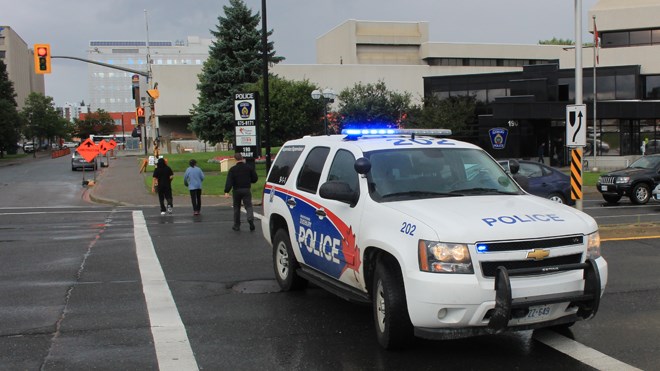Collision data collected by Greater Sudbury Police Service is pretty clear: Most collisions between vehicles and pedestrians occur in the late fall, specifically the end of October to the beginning of November.
As the days get shorter and the nights longer more motorists are travelling to and from work or operating their vehicles in darkness, raising the risk of collisions.
As the fall season extends into November and eventually into the winter months the driving environment and landscape also change, trees lose their leaves and the grass and ground are not as vibrant leaving little contrast between pedestrians and other their surroundings/environment.
That lack of contrast makes it harder to see detail, again, raising the risk for collisions.
With colder temperatures, road conditions can change quickly and pedestrians become more difficult to see when it is raining or snowing.
For the safety of all road users, motorists must adapt to the changing conditions and adjust their driving accordingly. On a related note, Daylight Savings this year occurs on Nov. 6, one week later than last year.
The police service is offering the following tips for pedestrians and motorists:
For pedestrians:
• Cross only at marked crosswalks or traffic lights. Don't cross in the middle of the block or between parked cars.
• Make sure drivers see you before you cross. If the driver is stopped, make eye contact before you step into the road.
• If possible, wear bright or light-coloured clothing or reflective strips, especially at dusk, when it's dark, raining or snowing.
• At a traffic light:
o Cross when traffic has come to a complete stop.
o Cross at the start of a green light.
o Don't cross once the “Don't Walk” signal starts to flash or the light turns yellow.
o Never cross on a red light.
• Watch for traffic turning at intersections (especially left turns) or turning into and leaving driveways.
• Stop, Look and Listen for traffic
• Obey crossing guards and school bus drivers
• Walk on the part of the sidewalk furthest away from the curb
• Walk facing traffic when there are no sidewalks
• Remove head phones when walking, riding, or playing near the road
• Pay attention, don’t walk distracted by texting or taking on cell phone
For Drivers:
Pay special attention to pedestrians as you drive. Here are some tips to follow:
• Always look for pedestrians, especially when turning within intersections.
• Watch for children. Drive slowly and cautiously through school zones, residential areas, or any other area where children could be walking or playing.
• Be patient, especially with seniors or pedestrians with disabilities who need more time to cross the road.
• Drive carefully near zones for passengers getting on and off school or city buses. Always be ready in case pedestrians make sudden or unexpected moves.
• At marked pedestrian crosswalks, yield the right-of-way to pedestrians in the crosswalk.
• Ensure all windows of your motor vehicle are clear and cleaned of dirt, ice or snow.
• Don’t be distracted by cell phones, electronic devices or conversation. Pay attention and be alert with two hands on the steering wheel.
• Drive according to the conditions of the road, slowdown in conditions of heavy rain, snow or on icy roads. Also be patient in bad weather as pedestrians may hurray and move unexpectedly to escape the elements.
• Ensure your motor vehicle is mechanically fit.
Stay within the maximum speed limit posted on signs along all roads. As a general rule, you will be safer if you drive at the same speed as traffic around you, without going over the speed limit.
Always drive at a speed that will let you stop safely, whether roads are wet, icy or dry.
Where there are no posted speed limit signs, do not drive faster than:
• 50 km/hour in cities, towns, villages and built-up areas
• 80 km/hour in any other area
For Parents:
Show your children how to cross a road safely. Teach them to:
• Stay to the side of the road, walking as far away from traffic as they safely can
• Stop and look both ways at the edge of the sidewalk before they cross a road
• Take extra care on roadways that have no curbs
• Watch out for blind corners (for example, a car coming out of an alley may not see a child pedestrian about to cross).



